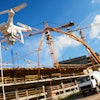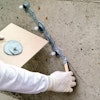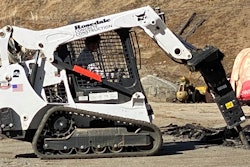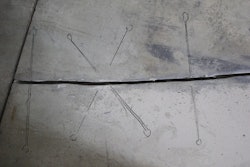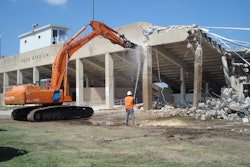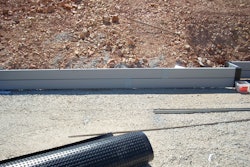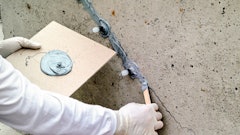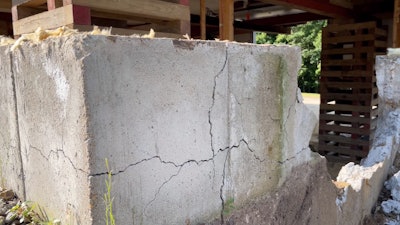
For many homeowners, the monthly mortgage payment is by far their biggest investment, and it’s generally considered a safe one. But what happens if their home starts to crumble? Sue Toomey paid 20 years of mortgage payments on her home—built in 1995—before she discovered her concrete foundation was crumbling because of defective concrete. Since repairing her home in 2019, she’s been a strong advocate for spreading the word about the issue.
 Crews raised the building six feet to allow for the foundation demolition and replacement.YANMAR Compact Equipment North America
Crews raised the building six feet to allow for the foundation demolition and replacement.YANMAR Compact Equipment North America
Toomey is the operations manager for Foundation Solutions of NE. Jeff Love, the company’s owner and primary equipment operator, founded the concrete replacement and remediation business in 2020 to focus on the crumbling concrete issue localized to portions of Connecticut and Massachusetts. The defective concrete was poured between 1983 and 2015 and contains pyrrhotite, a mineral that rusts and swells when it encounters oxygen and water. After 15 to 20 years, the affected concrete develops hairline cracks which then rapidly expand over the next several years. Love estimates tens of thousands of homes between Connecticut and Massachusetts are affected—about half the people he meets on the job are finding out about their crumbling foundation when attempting to sell.
He says home values typically drop to 10-20% of their original value once the problem is discovered.
To the relief of many, the state of Connecticut developed a program called the Connecticut Foundation Solutions Indemnity Company (CFSIC) to help eligible homeowners pay for repairs. The program’s creation opened the door for repair work that may otherwise not be feasible, including a two-year condominium foundation replacement project that was nearing completion in Willington, Connecticut as of August 2022. The complex was the first condo project funded by CFSIC and was being completed by Foundation Solutions, one of only about 35 contractors in the state approved for the work. Crews used a 1,925-pound-rated operating capacity ASV MAX-Series RT-65 compact track loader to pry up and haul out floor sections.YANMAR Compact Equipment North America
Crews used a 1,925-pound-rated operating capacity ASV MAX-Series RT-65 compact track loader to pry up and haul out floor sections.YANMAR Compact Equipment North America
The $2.52 million project began in March 2021 with a goal to replace the foundation of six buildings with 34 total units. To do so efficiently, the crew conducted the repairs in two phases involving three buildings in 2021 and three in 2022. Each foundation needed to be torn out completely to prevent contamination from old concrete, and then repoured.
When residents were moved out, Foundation Solutions used an ASV RT-40 compact track loader to demolish the garages and basements. The 4,005-lb. compact machine was the perfect size for working in the building before it was raised.
Following the interior demolition, crews cut the concrete floors and use a 1,925-lb.-rated operating capacity ASV MAX-Series RT-65 compact track loader equipped with forks to pry up and haul out floor sections, starting at the garage door opening.
Next, Foundation Solutions used a Yanmar ViO17 mini excavator to dig six-square-foot holes five feet deep to the bottom of the footing. These were used for cribbing stacks supporting as many as 18 jacking stations to lift the building. The 4,023-lb. ViO17’s compact size and true zero tail swing capabilities allowed it to dig in the tight space with ease. A 21,550-pound Yanmar SV100 did most of the heavy lifting from the outside, removing large sections of the foundation wall and breaking them down for disposal.YANMAR Compact Equipment North America
A 21,550-pound Yanmar SV100 did most of the heavy lifting from the outside, removing large sections of the foundation wall and breaking them down for disposal.YANMAR Compact Equipment North America
A building lifting contractor then raised the structure 6 ft. Love used a 12,247-lb. Yanmar ViO55 mini excavator under the building to demolish a four-foot-wide, 12-in. deep section of concrete that couldn’t be removed until the structure was in the air. A 21,550-lb. Yanmar SV100 did most of the heavy lifting from the outside, removing large sections of the foundation wall and breaking them down for disposal.
A previous attempt to fix the issue by a different company added a week’s worth of work during this stage. Engineers had installed a precast concrete block system with long 4x4-foot blocks of solid concrete. Despite the blocks being too heavy to lift with the SV100, Love was able to roll the concrete away from the structure to be disposed of.
Once crews had removed all the old concrete, Foundation Solutions poured new walls and used the RT-40 and RT-65 to grade the floors inside—taking advantage of the machines’ low ground pressure and ability to operate on the dirt surface without damaging plumbing buried just a couple of inches below. From there, crews completed backfill and other dirt work outside, poured new concrete floors, reframed the walls, and added other finishing touches. Love was impressed by the SV100’s power while moving and breaking concrete.YANMAR Compact Equipment North America
Love was impressed by the SV100’s power while moving and breaking concrete.YANMAR Compact Equipment North America
Love says that because of the success of this and other projects, he hopes to expand further into Massachusetts to continue to help as many homeowners as possible.
About the author
Aaron Boerner is a writer and videographer for the construction industry.
